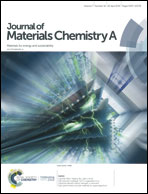Tuning copper sulfide nanosheets by cation exchange reactions to realize two-dimensional CZTS dielectric layers†
Abstract
Design of two-dimensional (2D) quaternary copper–zinc–tin–sulfide (Cu2ZnSnS4, CZTS) nanosheets (NSs) consisting of purely earth abundant elements with desired morphologies, compositions and phases is challenging by conventional colloidal synthesis routes. Here we report the colloidal synthesis of ultra-thin (∼2 nm) phase-pure 2D wurtzite CZTS NSs using 2D copper sulfide (Cu2S) NSs as a template. We incorporated Zn(II) and Sn(IV) ions into the crystal lattice of Cu2S NSs retaining the 2D shape via controlled cation exchange reactions. The reaction protocol allows the achievement of the desired elemental composition of the NSs by varying the composition of the precursors. CZTS NSs with a large planar area exhibit a nearly temperature and frequency independent dielectric constant (>6.1) with a low dielectric loss over broad temperature and frequency ranges which makes the system an effective 2D dielectric material. The template based cation exchange reaction protocol provides a guideline to obtain phase-pure CZTS by avoiding the secondary phases often associated with the colloidal synthesis routes. This work demonstrates the realization of 2D quaternary dielectric non-oxide semiconductors composed of purely earth abundant elements for miniaturized energy storage devices using flexible solution processed routes.



 Please wait while we load your content...
Please wait while we load your content...